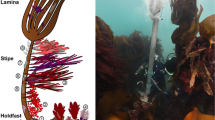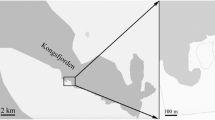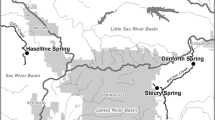Abstract
The kelp Laminaria hyperborea provides a habitat for a diverse invertebrate community. Invertebrate abundance is particularly high in the kelp holdfasts and associated with epiphytes on the stipes. We investigated colonisation patterns of this fauna on artificial substrata (holdfast and epiphyte mimics) exposed for short time periods in the kelp forest in two seasons, summer and late autumn. Within 7 days, 99 taxa common on natural kelp substratum colonised the artificial substrata in large numbers, demonstrating high mobility and indicating that there may be a rapid exchange of individuals and species among algae. Gastropods and amphipods were the most abundant colonisers. In summer, a specific “epiphyte fauna” could be distinguished from a “holdfast fauna”, and species associated with epiphytes were significantly more abundant on the artificial substrata. Colonisation was more rapid in summer than in late autumn, which may be related to animal population density. The high dispersal rate can facilitate the interaction with other communities and with higher trophic levels in the kelp-forest food web.
Similar content being viewed by others
References
Aitkin M, Anderson D, Francis B, Hinde J (1989) Statistical modelling in GLIM. Clarendon Press, Oxford
Alldredge AL, King JM (1977) Distribution, abundance, and substrate preferences of demersal reef zooplankton at Lizard Island Lagoon, Great Barrier Reef. Mar Biol 41:317–333
Alldredge AL, King JM (1985) The distance demersal zooplankton migrate above the benthos: implications for predation. Mar Biol 84:253–260
Bayne BL (1964) Primary and secondary settlement in Mytilus edulis L. (Mollusca). J Anim Ecol 33:513–523
Begon M, Harper JL, Townsend CR (1990) Ecology, individuals, populations and communities. Blackwell, Oxford
Borowsky B (1983) Reproductive behaviour of three tube-building peracarid crustaceans: the amphipods Jassa falcate and Ampithoe valida and the tanaid Tanais cavolinii. Mar Biol 77:257–263
Bray JR, Curtis JT (1957) An ordination of the upland forest communities of southern Wisconsin. Ecol Monogr 27:325–349
Chapman MG (2000) A comparative study of differences among species and patches of habitat on movements of three species of intertidal gastropods. J Exp Mar Biol Ecol 244:181–201
Charnov EL (1976) Optimal foraging theory: the marginal value theorem. Theor Popul Biol 9:129–136
Christie H (1995) Description of the kelp forest fauna at Froan, mid-Norway; variation in an exposure gradient (in Norwegian with English abstract) NINA Oppdragsmelding 368:1–22
Christie H, Fredriksen S, Rinde E (1998) Regrowth of kelp and colonization of epiphyte and fauna community after kelp trawling at the coast of Norway. Hydrobiologia 375/376:49–58
Conradi M, López-González PJ, García-Gómez C (1997) The amphipod community as a bioindicator in Algeciras bay (southern Iberian peninsula) based on a spatio-temporal distribution. Mar Ecol 18:97–111
Edgar GJ (1983a) The ecology of south-east Tasmanian phytal animal communities. I. Spatial organization on a local scale. J Exp Mar Biol Ecol 70:129–157
Edgar GJ (1983b) The ecology of south-east Tasmanian phytal animal communities. IV. Factors affecting the distribution of ampithoid amphipods among algae. J Exp Mar Biol Ecol 70:205–225
Edgar GJ (1991) Artificial algae as habitats for mobile epifauna: factors affecting colonization in Japanese Sargassum bed. Hydrobiologia 226:111–118
Erlandsson J, Kostylev V (1995) Trail following, speed and fractal dimension of movement in a marine prosobranch, Littorina littorea, during a mating and a non-mating season. Mar Biol 122:87–94
Fjøsne K, Gjøsæter J (1996) Dietary composition and the potential of food competition between 0-group cod (Gadus morhua L.) and some other fish species in the littoral zone. J Mar Sci 53:757–770
Foster-Smith RL, Shillaker RO (1977) Tube irrigation by Lembos websteri Bate and Corophium bonnelli Miine-Edwards (Crustacea: Amphipoda). J Exp Mar Biol Ecol 26:289–296
Franz DR, Mohamed Y (1989) Short-distance dispersal in a fouling community amphipod crustacean, Jassa marmorata Holmes. J Exp Mar Biol Ecol 133:1–13
Ghelardi RS (1960) Structure and dynamics of the animal community found in Macrocystis pyrifera holdfasts. PhD thesis, University of California, La Jolia, Calif.
Gosselin LA, Chia F-S (1995) Distribution and dispersal of early juvenile snails: effectiveness of intertidal microhabitats as refuges and food resources. Mar Ecol Prog Ser 128:213–223
Hacker SD, Steneck RS (1990) Habitat architecture and the abundance and body-size-dependent habitat selection of a phytal amphipod. Ecology 71:2269–2285
Hammer RM (1981) Day-night differences in the emergence of demersal zooplankton from a sand substrate in a kelp forest. Mar Biol 62:275–280
Hart PJB (1993) Teleost foraging: facts and theories. In: Pitcher TJ (ed) Behaviour of teleost fishes. Chapman and Hall, London, pp 253–284
Hickmann CP Jr, Roberts LS, Larson A (1993) Integrated principles of zoology. Mosby, St. Louis, Mo.
Holmlund MB, Peterson CH, Hay ME (1990) Does algal morphology affect amphipod susceptibility to fish predation? J Exp Mar Biol Ecol 139:65–83
Jacobi CM, Langevin R (1996) Habitat geometry of benthic substrata: effects on arrival and settlement of mobile epifauna. J Exp Mar Biol Ecol 206:39–54
Johnson BJ, Attramadal YG (1982) A functional-morphological model of Tanais cavolinii Milne-Edwards (Crustacea. Tanaidacea) adapted to a tubicolous life-strategy. Sarsia 67:29–42
Jones DJ (1971) Ecological studies on macroinvertebrate populations associated with polluted kelp forests in the North Sea. Helgol Wiss Meeresunters 22:417–441
Kain J (1967) Populations of Laminaria hyperborea at various latitudes. Helgol Wiss Meeresunters 15:489–499
Kennelly SJ (1983) An experimental approach to the study of factors affecting algal colonization in a sublittoral kelp forest. J Exp Mar Biol Ecol 68:257–276
Kennelly SJ (1991) Caging experiments to examine the effects of fishes on understorey species in a sublittoral kelp community. J Exp Mar Biol Ecol 147:207–230
Kruskal JB (1964a) Multidimensional scaling by optimizing goodness-of-fit to a nonmetric hypothesis. Psychometrica 29:1–28
Kruskal JB (1964b) Nonmetric multidimensional scaling: a numerical method Psychometrica 29:115–129
Kuno E (1981) Dispersal and the persistence of populations in unstable habitats: a theoretical note. Oecologia 49:123–126
Martel A, Diefenbach T (1993) Effects of body size, water current and microhabitat on mucous-thread drifting in post-metamorphic gastropods Lacuna spp. Mar Ecol Prog Ser 99:215–220
Martin-Smith KM (1993) Abundance of mobile epifauna: the role of habitat complexity and predation by fishes. J Exp Mar Biol Ecol 174:243–260
Milinski M (1993) Predation risk and feeding behaviour. In: Pitcher TJ (ed) Behaviour of teleost fishes. Chapman and Hall, London, pp 285–305
Moore PG (1972a) The kelp fauna of northeast Britain. I. Introduction and the physical environment. J Exp Mar Biol Ecol 13:97–125
Moore PG (1972b) Particulate matter in the sublittoral zone of an exposed coast and its ecological significance with special reference to the fauna inhabiting kelp holdfasts. J Exp Mar Biol Ecol 10:59–80
Moore PG (1973a) The large Crustacea associated with holdfasts of keip (Laminaria hyperborea) in north-east Britain. Cah Biol Mar XIV:493–518
Moore PG (1973b) The kelp fauna of northeast Britain. II. Multivariate classification: turbidity as an ecological factor. J Exp Mar Biol Ecol 13:127–163
Moore PG (1986) Levels of heterogeneity and the amphipod fauna of kelp holdfasts. In: Moore PG, Seed R (eds) The ecology of rocky coasts. Colombia University Press, New York, pp 274–290
Nair KKC, Anger K (1979) Experimental studies on the life cycle of Jassa falcata (Crustacea, Amphipoda). Helgol Wiss Meeresunters 32:444–452
Neison WG (1979) Experimental studies of selective predation on amphipods: consequences for amphipod distribution and abundance. J Exp Mar Biol Ecol 38:225–245
Nordeide JT, Fosså JH (1992) Diet overlap between two subsequent year-classes of juvenile coastal cod (Gadus morhua L.) and wild and reared cod. Sarsia 77:111–117
Pavia H, Carr H, Åberg P (1999) Habitat and feeding preferences of crustacean mesoherbivores inhabiting the brown seaweed Ascophyllum nodosum (L.) Le Jol. and its epiphytic macroalgae. J Exp Mar Biol Ecol 236:15–32
Sánchez-Jerez P, Barberá-Cebrián C, Ramos-Esplá A (1999) Daily vertical migrations in the epifauna associated with Posidonia oceanica meadows. J Mar Biol Assoc UK 79:971–977
Schultze K, Janke K, Krüß A, Weidemann W (1990) The macrofauna and macroflora associated with Laminaria digitata and L. hyperborea at the island of Helgoland (German Bight, North Sea). Helgol Wiss Meeresunters 44:39–51
Shepard RN (1962) The analysis of proximities: multidimensional scaling with an unknown distance function. II. Psychometrika 27:219–246
Shillaker RO, Moore PG (1987) The feeding habits of the amphipods Lembos websteri Bate and Corophium bonellii Milne-Edwards. J Exp Mar Biol Ecol 110:93–112
Sjøtun K, Fredriksen S, Lein TE, Rueness J, Sivertsen K (1993) Population studies of Laminaria hyperborea from its northern range of distribution in Norway. Hydrobiologia 260/261: 215–221
Skadsheim A, Christie H, Leinaas HP (1995) Population reductions of Strongylocentrotus droebachiensis (Echinodermata) in Norway and the distribution of its endoparasite Echinomermella matsi (Nematoda). Mar Ecol Prog Ser 119:199–209
Sloane JF, Bassindale R, Davenport E, Ebling FJ, Kitching JA (1961) The ecology of Lough Ine. IX. The flora and fauna associated with undergrowth-forming algae in the Rapids area. J Ecol 49:353–368
Southgate T (1982) Studies on an intertidal population of Rissoa parva (Gastropoda: Prosobranchia) in south-west Ireland. J Nat Hist 16:183–194
Stachowitcz JJ, Hay M (1999) Reduced mobility is associated with compensatory feeding and increased diet breadth of marine crabs. Mar Ecol Prog Ser 188:169–178
Strathmann RR, Strathmann MF (1982) The relationship between adult size and brooding in marine invertebrates. Am Nat 119:91–101
Stretch JJ (1985) Quantitative sampling of demersal zooplankton: reentry and airlift dredge sample comparisons. J Exp Mar Biol Ecol 91:125–136
Tokeshi M (1994) Community ecology and patchy freshwater habitats. In: Giller PS, Hildrew AG, Raffaelli DG (eds) Aquatic ecology: scale, pattern, and process. Blackwell, Oxford, pp 63–92
Ulrich I, Anger K, Schöttler U (1995) Tube-building in two epifauna amphipods species, Corophium insidiosum and Jassa falcata. Helgol Wiss Meeresunters 49:393–398
Virnstein RW, Curran MC (1986) Colonization of artificial seagrass versus time and distance from source. Mar Ecol Prog Ser 29:279–288
Warén A (1996) Ecology and systematics of the north European species of Rissoa and Pusillina (Prosobranchia: Rissoidae). J Mar Biol Assoc UK 76:1013–1059
Whittick A (1983) Spatial and temporal distribution of dominant epiphytes on the stipes of Laminaria hyperborea (Gunn) Fosi (Phaeophyta: Laminariales) in S.E. Scotland. J Exp Mar Biol Ecol 73:1–10
Winder L (1990) Predation of the cereal aphid Sitobion avenae by polyphagous predators on the ground. Ecol Entom 15:105–110
Youngbluth MJ (1982) Sampling demersal zooplankton: a comparison of field collections using three different emergence traps. J Exp Mar Biol Ecol 61:111–124
Author information
Authors and Affiliations
Corresponding author
Additional information
Communicated by L. Hagemann, Helsingør
Published online: 13 August 2002
Rights and permissions
About this article
Cite this article
Norderhaug, K.M., Christie, H. & Rinde, E. Colonisation of kelp imitations by epiphyte and holdfast fauna; a study of mobility patterns. Marine Biology 141, 965–973 (2002). https://doi.org/10.1007/s00227-002-0893-7
Received:
Accepted:
Issue Date:
DOI: https://doi.org/10.1007/s00227-002-0893-7




